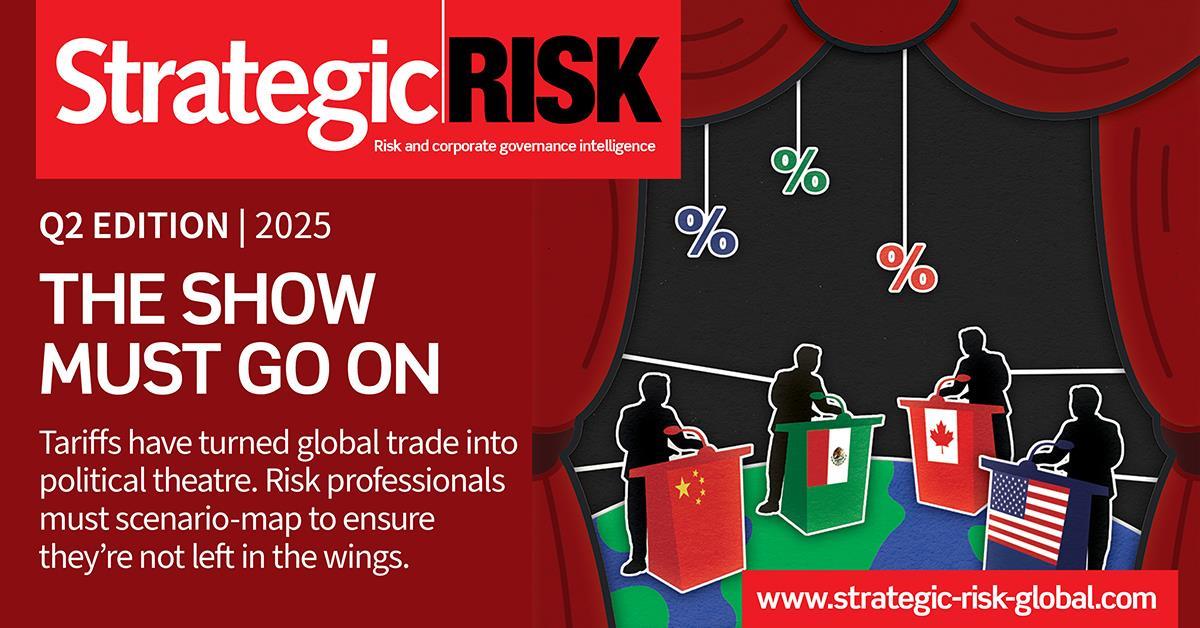The president of FERMA, Thierry van Santen, acted as moderator and introduced the participants: US and French lawyer, Ma'tre Reid Feldman, partner, LeBoeuf, Lamb, Greene & MacRae; Jean-Paul Rignault, CEO, AXA Corporate Solutions and Yves Boclinville, group risk manager, InBev.
REID FELDMAN: My talk will focus on this basic point: changes in the corporate governance environment are creating increased D&O risks.
We all know about recent celebrated cases, involving violations of classic rules: theft, fraud, violations of securities laws, management abuse and self-dealing. The result has been changes in the corporate governance environment, in two ways.
The first change has been enactment of new mandatory rules. These include Sarbanes-Oxley in the US and legislative reform in Europe. And there will be more legislative reform in Europe that will affect the risks for directors and officers.
The second change, which is just as important, is increased sensitivity of regulators, prosecutors, shareholders and third parties to violations of the new and existing rules. That will lead to increased risks of D&O liability.
The US environment
To illustrate these points, I will start with a description of the environment in the US. This is important for European companies, both because some European companies are listed in the US, or have operations in the US, and also because what happens in the US often furnishes guidelines as to what is going to happen in Europe.
One important aspect of the US environment is the risk of liability for securities law violations. As we know, the US has a system of class actions, which allow a few individuals and a few lawyers to bring a lawsuit based on the harm to a very large number of people. This is supposed to serve a public policy purpose, but it has led to some distortions, and some very, very large awards. In addition, today, there is increased public enforcement of these securities rules, by the Securities and Exchanges Commission (SEC) and other regulators.
A second important aspect of the US D&O environment relates to corporate law issues. These include the standards in the US as to what is the liability of a director and an officer to a company. In this area the business judgement rule gives some, but not absolute, protection to directors acting in good faith. Another source of protection for directors and officers of a US company is the system of indemnification. This allows a provision in the by-laws of the company to require or permit the company to reimburse or pay the legal fees that the directors and officers may incur if they are defendants in a lawsuit, and also the damages or settlements that they may have to pay.
A third key aspect of the US environment is that the new rules mentioned above, including the Sarbanes-Oxley legislation, have resulted in an emphasis on procedures and documentation. In fact, one way you can characterise the atmosphere in the US when it comes to these procedures and this documentation is what I call 'no-fault is too small.' In other words, there is no mistake which is too small to be criticised in the case of litigation. That means that people in the US are very concerned with dotting all the 'i's and crossing all the 't's.
Corporate governance in Europe
The corporate governance environment here in Europe results, in the first instance, from legislation in the member states. There is great similarity across Europe in corporate structures and basic governance concepts, rules about preparing financial accounts and standards in the capital markets, as well as corporate governance codes, which contain rules about independent directors, board committees, disclosures, tightened procedures, similar to what we see in this US.
Over 40 of these codes have been promulgated in the EU over the past decade, but there has been a general convergence of the rules, so that a company that is subject to corporate governance codes in many European countries can usually live with all of them, even when there are discrepancies.
This is because of the generally applied principle that the company is allowed to explain why it makes no sense to comply.
With respect to shareholder rights, what can a European shareholder do if he or she or it, (in the case of an institutional investor), is unhappy with the way the company is being run? Litigation in Europe generally does not include the equivalent of the US class action system. Further, even in those countries where a shareholder can sue management for harm to the shareholder because of a management mistake, for example, generally the right to recovery is a right of the company and not a right which can benefit the shareholder personally. What that means is that there is not the same kind of motivation here in Europe as in the US for shareholders to go out and sue the company.
When it comes to liability standards, there are differences in the way they are expressed among European countries, and there are some conceptual differences, but the practical result is very similar across European countries.
In the UK, the director has the obligation to carry out his or her responsibilities with care, skill and diligence. The director is prohibited from using his or her powers for a collateral purpose. A judge in England may excuse from liability a director who has made a mistake when it is felt that he or she has acted honestly and reasonably. A procedure in the UK allows shareholders to approve certain actions taken by directors, called a 'whitewash' procedure. The net result is that in the UK, there has traditionally been a general feeling that a director who acts honestly and in good faith probably won't run much risk of having personal liability. There are winds of change, however, in the UK, and there is probably more litigation on this subject there than in any other European country.
The standard in Germany is similar. The director or officer has the obligation to act as a diligent and conscientious business person. There is some concern in Germany as to whether or not the courts will apply a counterpart to the US business judgement rule - that somebody who is acting in good faith, exercising business judgement in a reasonable way, will be excused from liability. There is even a proposal to reform the law on that subject.
However, some feel that this standard is already incorporated into the existing law.
My own feeling is that these standards come down to pretty much the same thing in most of our countries. With respect to differences, I mentioned that the UK probably has an attitude which is more pro-litigation - dangerous for the directors in terms of possible personal liability - than the other countries, at least so far. But in all these countries there is, as in the US, increased sensitivity to violations of corporate governance rules.
We should note that in France, as in some other countries, rules enacted recently impose new reporting requirements - specifically, in France, annual reports on the board's operating procedures and internal management controls. Such reports, I think, may increase the risk environment, because the more detail you get into the hands of the shareholders and the public, the more there is an opportunity for somebody to call you to task later on down the line. I call these additional reporting requirements more 'grist to the mill' of litigation.
EU rules
The final ingredient in understanding the corporate governance environment here in Europe, and how it is going to evolve in the future, is the EU Commission. The Commission's apparent goal is to shake up the European corporate environment. Frits Bolkestein, the outgoing EU commissioner for the internal market, says very clearly that there should be convergence between Europe and the US, because "shareholders want to be clear that in Europe and America we have the same underlying principles of effective management of boards". He says this can be done through convergence: basically having the same standards, or equivalence: having similar standards.
To achieve this goal, the EU Commission has announced that it is going to propose new measures. We're not sure what they will be, but they may include uniform standards EU-wide. In order for these measures to furnish effective motivation for changing behaviour, they may have to be enforceable.
This 'activist' EU legislative programme, plus the legislation already enacted and still on the drawing board in member states, probably means that there is going to be a more favourable environment for litigation than in the past.
Litigation as a tool of social policy change is a blunt instrument. It can result in some strange and unexpected decisions. I do not believe that this will create the equivalent of the American situation, but we are going to have a change in the environment here in Europe.
New rules + new tasks + new attitudes = new risks
To sum up, it seems that in both the US and Europe we are faced with new legislative rules, new tasks for managers and new attitudes by regulators and the public, which all add up to new risks for D&O exposure. In this environment, senior managers are naturally very attentive to what risk managers may tell them about exposures. Of course, these developments make it important to review D&O policies very carefully, since there can be significant differences among coverages offered in the market.
JEAN-PAUL RIGNAULT: I will try to provide some figures and data that demonstrate that D&O insurance is more security than illusion. From an insurer's point of view, Sarbanes-Oxley was clearly a step change in the accountability of listed corporations. It created new requirements, new obligations and new responsibilities. Another aspect that should be highlighted is that regulators are demonstrating that they are willing to use the powers that now exist. This is clearly a source of potential legal action, maybe from shareholders as well. Financial security laws, accounting standards and so on, will create greater expectations in terms of transparency, risk disclosure and information not only from shareholders but from all stakeholders, including financial analysts, rating agencies, clients, and employees.
Ultimately, what we all working for is to develop corporate governance.
Directors are under scrutiny and exposed to lawsuits. It is a pretty broad liability they have. Prevention is definitely better than cure, but less simple than it may appear. Take transparency as an example. Disclosure is good risk management but in some cases, it may create more risk. So it is something that should be looked at and balanced.
Figures from the GenRe web site (see table) show that over the past three or four years, about $1bn dollars in judgements and settlements have been made against directors and officers of European companies. I think that a significant proportion of that $1bn dollars was supported by D&O insurance.
Is that illusion? Definitely, no. According to the Insurance Information Institute (III) in the US, many insurers have experienced adverse loss ratios, claims result deterioration, and some losses for their D&O business over the past five years. Is it illusion? No, for me, it is a cruel reality.
AXA Corporate Solutions is a general insurer and not a niche specialist, but we are involved in D&O insurance. The largest claim we have paid up to now is £18m, which was part of an £83m settlement. Is that illusion?
My boss thinks it's pretty good security. I share his concern with you.
Policy issues
Initially in the late 1980s and early 1990s, D&O insurance essentially focused on covering any wrongful act committed or allegedly committed by directors and officers. Step by step, the scope of D&O insurance policy has changed. Now you have basic coverage extensions, three of them at least: defence costs for criminal liability and fraud; protection for services by directors and officers of affiliated entities where they may be serving at the request of the organisation, and personal liability relative to employment practice claims.
Over the same period various elements have been changing significantly in the insurance market. There is greater risk selection from the insurance company. There have been some cut backs on limits, willingness to control all potential accumulation and pressure on costs through rate increases, as well as stronger exclusions.
If you look at our loss history over the past 10 years, you'll see that breach of fiduciary duty is the number one cause of claims. Employment practice comes as number two and crime/fraud is number three. Securities and insolvencies were smaller in number, but, in terms of value, this area is the most expensive one. Contractual liability is a lawsuit brought by a client or supplier. Of about 1,000 claims, 40% were brought in the US, which clearly highlights the exposure that a company operating in the US has, especially when it raises capital there.
The future
Is D&O still an insurable class of business? Definitely - but under certain conditions. From time to time, there is a question about how available this class of insurance is and, if available, how affordable it is. Clearly, these are issues we have to discuss.
We have heard it described how difficult it is for a director to understand all the details of the company he or she is working in. He or she needs training, experience, and so on. The way that most companies conduct their business is pretty complex, even for an insurance company underwriter to understand. It can be pretty hard for us to quantify the exposure, and the answers that we provide to risk managers are directly linked to this exposure. D&O can be a difficult class of business.
Ultimately, one of my conclusions would be that everything has to do with prevention, with corporate governance and sometimes with sustainable development. It's part of the growing concept of how business is to manage the risks that are linked directly to its operations. As a response to the question 'security or illusion?', we answer that it's definitely real.
THIERRY VAN SANTEN: I would now like to get the opinion of a consumer.
YVES BOCLINVILLE: InBev is a recent combination between two major players in the worldwide beer industry in Europe. One was Interbrew in Europe and the other AmBev in Brasil, the leader in South America. You can imagine the result of this combination. We have been faced with a major challenge, which was to redesign and restructure all the directors' and officers' coverage, not only for the directors and officers of the holding company, but all directors and officers of the corporation. This is something that you have to keep in mind, certainly in a corporation where you have other entities listed in some markets.
As a result of the combination, we had various entities listed in several markets, including the US, which the insurance market does not appreciate.
The first question was - do we have the choice whether or not to place coverage? And the answer was no. Why? If we hire, appoint or elect independent directors, their first question, even before they are hired, will be what coverage will they have? So, if you want independent directors, you have no choice.
You have to consider what coverage to buy. It is quite a difficult question to answer. Things have changed. Liabilities have increased. Do we suggest one single programme, or will we consider having some policies placed in some markets, and excesses to cover various companies? These are very important questions that we had to address before making a recommendation to the board.
Another point was critical. What do we have to disclose? We could reveal an aggravation of risk that will leave the insurer, in Belgium, certainly, with the right to cancel or amend or restrict coverage. It was not easy to convince people from the legal department or senior management that it was crucial to have a first contact with the market to address the question.
Thanks to good cooperation between the market and the corporation, we have been able to keep coverage based on the historical negotiated conditions.
It was a good result considering that we had to redesign and restructure at the moment of the closing. Another point was the merger, which we had to officialise based on meetings on both sides of the ocean. The coverage had to be amended at the moment of the decision, before having received the approval of the new board, because it was not yet appointed. It was not easy, but we found a solution.
Then what limit? We have various options. The first was to buy only an amount which will cover the legal defence. Or, should we try to protect ourselves by buying limits which will represent what we can assess as a possible claim? But how much should that be? I don't know - $5m, $15m, $100m, $200m or $300m? We tried to find some benchmarks to compare the loss history in other companies with similar exposure, and we finally decided an amount.
Then you have to address your request to the market, calling the various players and trying to obtain what kind of coverage? Standard? We were covered with a manuscript wording. Would it still be possible to obtain that kind of wording? Difficult, really difficult. But the wording was fine. The carrier agreed to give something similar to what we had.
Capacity is limited, so how to address excess was a problem. We were very surprised to hear from the market: 'Give me the quote from the primary and I'll give you my quote'. We had provided a full set of information - such a big file - and they were requesting the quote of the primary to give us a quote for the excess. But we had no choice. We addressed the issue and finally obtained the redesigned coverage.
So to the question. Illusion, there is certainly not. Coverage - I have some question marks. Maybe it is an illusion of security.
This article is an abridged version of the presentation given to the FERMA seminar held in Brussels in October 2004. The participants' presentations are available from the FERMA web site:




















